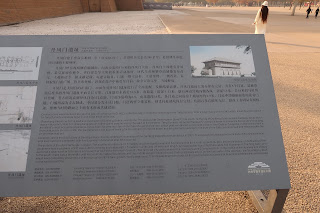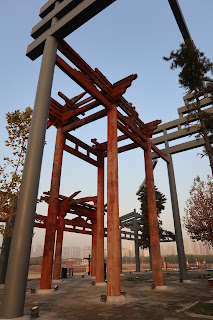1 Dec 18
I had the opportunities to travel to China extensively over the last 30 years. From East to West, South to North and many remote provinces, my main observation of China is that China is on the move and moving too fast, many countries will be left behind.
So much historical information is seen through the lens of the western civilisation. Many historical facts are written and promulgated by western historians. Unfortunately many of these experts were ignorant of the eastern civilisation.
For the past 500 years, the powers are from the west and colonisation by these power were prevalent in the East. Slavery from the African nation was the hallmark of western supremacy and power.
The common usage of western languages allowed it to become official language for commerce and education. Rules and laws are based on western standard. Educational material too are mainly published by the west and translated for Asian consumption. Undoubtedly, mindset and values are heavily influenced the new generation of people. Norms are thus set according to western values. That is all right but when the values of eastern civilisation is challenged, it can cause disharmony and division.
So today most of Asian has a very favourable perceptions of the west. Subconsciously we are even influence by many biased perceptions of the East.
For me as a Singapore Chinese, it's quite alarming that many of our countrymen still harbour negative and biased thoughts of China. The real reason is the lack of understanding Chinese history and culture.
Our fore fathers had migrated to S E Asia due to economic hardship and has found their pot of gold. But nothing is static and it would be naïve to think the new found opportunities will last forever. I would not be surprised if future generations have to return to China to seek better opportunities.
I based my observation on my vast travel experiences in China over the last 30 years. Compare with developed countries, the infrastructure developed is beyond world class. Someday, other countries will have to benchmark it to Chinese standard.
One just to walk in any city centre, be it Beijing or 3 tiered cities, one would feel the vibrancy and sensed of development and modernity. E payment is the standard and I too believe China has set the benchmark for other countries to emulate.
No need to go further. One got to see and feel it China, be it in a village or a city.
Sunday, 2 December 2018
Thursday, 29 November 2018
Wednesday, 28 November 2018
Xian other attractions
28 Nov 18
Visited these sites today. A short notes of these sites copied from China Travel Guide
Xi'an Museum
Xi'an Museum was opened to the public on the World Museum's Day, May 18th, 2007. As many as 130, 000 fine cultural relics are kept here, most of which were unearthed in the important tombs and the capital sites of the Zhou Dynasty (11th century BC-221 BC), the Qin Dynasty (221 BC-206 BC), the Han Dynasty (206 BC-220 AD), and the Tang Dynasty (618-907). More than 2,000 of these articles reflect the outstanding technological achievements of past dynasties.
It is a three-storied building, with an underground floor unseen from the outside. The underground exhibition hall features many relics that have been unearthed, showing the history of Xi'an, the one-time capital of 13 dynasties, its economy, social life, as well as cultural exchange and trade with foreign countries.
Small Wild Goose Pagoda
Daming Palace of the Tang Dynasty
Featuring its super-large scale and magnificent buildings, Daming Palace was the main royal palace in Tang Dynasty (618 - 907) where Tang emperors lived and dealt with state affairs. It was destroyed after Tang Dynasty. On June 22, 2014, it was included in the World Heritage List.
It was located in Longshou area in the northeast of Chang'an City (today's Xi'an). Covering a large area of 3 sq km (1.2 sq mi), it measured 2.5 km (1.6 mi) long and 1.4 km (0.9 mi) wide. Originally, the Emperor Li Shimin built it as the summer palace for his father, the Emperor Li Yuan. The palace had nine gates. The Daming Palace layout was composed of two areas, Qian Chao where emperors held court, and Nei Ting used for living and recreation.
Visited these sites today. A short notes of these sites copied from China Travel Guide
Xi'an Museum
Xi'an Museum was opened to the public on the World Museum's Day, May 18th, 2007. As many as 130, 000 fine cultural relics are kept here, most of which were unearthed in the important tombs and the capital sites of the Zhou Dynasty (11th century BC-221 BC), the Qin Dynasty (221 BC-206 BC), the Han Dynasty (206 BC-220 AD), and the Tang Dynasty (618-907). More than 2,000 of these articles reflect the outstanding technological achievements of past dynasties.
It is a three-storied building, with an underground floor unseen from the outside. The underground exhibition hall features many relics that have been unearthed, showing the history of Xi'an, the one-time capital of 13 dynasties, its economy, social life, as well as cultural exchange and trade with foreign countries.
Small Wild Goose Pagoda
| |
The Small Wild Goose Pagoda is located on the central axis of the Jianfu Temple in south Xi'an. As a national AAAA scenic spot and a world heritage site, the Buddhist pagoda survives from the Tang Dynasty (618-907). Tourists can learn about the history and culture of Xi'an by visiting the pagoda and the Xi'an Museum in the southwest of the temple. The pagoda is not as famous as the Giant Wild Goose Pagoda, but is more peaceful and tranquil. As part of the artistic heritage of Buddhist architectures of the Tang Dynasty, it witnessed how Buddhism was introduced to China and integrated with the culture of Han nationality.
Daming Palace of the Tang Dynasty
Featuring its super-large scale and magnificent buildings, Daming Palace was the main royal palace in Tang Dynasty (618 - 907) where Tang emperors lived and dealt with state affairs. It was destroyed after Tang Dynasty. On June 22, 2014, it was included in the World Heritage List.
It was located in Longshou area in the northeast of Chang'an City (today's Xi'an). Covering a large area of 3 sq km (1.2 sq mi), it measured 2.5 km (1.6 mi) long and 1.4 km (0.9 mi) wide. Originally, the Emperor Li Shimin built it as the summer palace for his father, the Emperor Li Yuan. The palace had nine gates. The Daming Palace layout was composed of two areas, Qian Chao where emperors held court, and Nei Ting used for living and recreation.
Subscribe to:
Comments (Atom)














































































